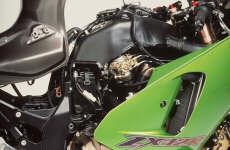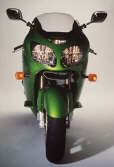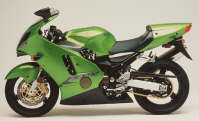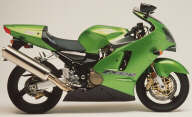
2000 Kawasaki ZX-12
|
The most anticipated new motorcycle for the year 2000 is finally, officially debuted by Kawasaki. These are the official photos and specs from Kawasaki’s press kit.
In order for you to take an extremely close look at this marvelous bike, we are including smaller images on this main article page, which you can click to open a large detailed photo. These images will take a while to load, but it is well worth it.
The official ZX12R specifications are set forth below. The bike weighs in at 476.3 pounds dry and has a wheelbase of 56.5 inches. It has huge front disc brakes — 320mm each — pinched by six piston calipers.
The front fork is a 43mm inverted design, which is adjustable for compression, rebound, and spring preload. The rear suspension is also adjustable for compression, rebound and preload, as well as ride height.
The rear tire is a massive 200 section — a virtual necessity given the incredible horsepower this machine will produce. Speaking of horsepower, Kawasaki has yet to release a precise figure, but will state only that “the new ZX-12R engine produces more horsepower from its 1,198cc displacement than any other machine in its class.” Assuming Kawasaki considers the Suzuki Hayabusa to be in the same class as the ZX-12R, and it should, the 12R will produce more than the approximately 180 crankshaft horsepower produced by the Hayabusa.
The attention to detail in the ZX-12R’s design is truly phenomenal. The amount of magnesium and titanium used in the ZX-12R is unprecedented for a machine in this class. But it is the ZX-12R’s frame and aerodynamics that truly set this motorcycle apart from the Hayabusa. As reported earlier, the frame is a backbone “over the top of the engine” design, made entirely of aluminum. According to Kawasaki “this design significantly reduces overall width for better aerodynamics and a more radically streamlined look while retaining the stiffness and rigidity of a twin-spar frame.” The 12R even employs a removable aluminum subframe.
Further evidence of Kawasaki’s attention to detail includes the fact that the upper fork crown is cast aluminum to reduce weight, while the lower clamp is forged aluminum for strength and rigidity (where it is needed most).
The ZX-12R spent more time in a wind tunnel during its development phase than any other motorcycle in Kawasaki’s history, and is substantially narrower (due to the unique frame design) than any machine in its class. Small winglets on either side of the fairing contribute significantly to the management of turbulent airflow coming off the front wheel. Small wind deflectors are even cast into the bottom of the forks to send air around the fairing, rather than directly into the body of the machine.
Of course, Kawasaki isn’t telling us what the top speed of the ZX-12R is. We’ll have to wait for road testing, and dyno testing, for speed and horsepower figures, although Kawasaki may ultimately release official horsepower and torque figures to the press.
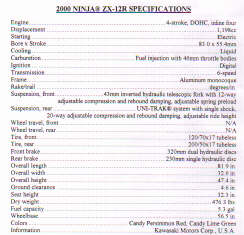 |
Official Specs
|
You can follow any responses to this entry through the RSS 2.0 feed.
Both comments and pings are currently closed.

